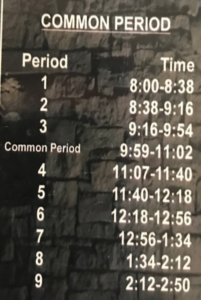By SAM WATTERS ‘18
On Wednesday, September 13, the school introduced a new schedule to their already expansive list of timetables – the common period. This 63 minute break between third and fourth periods allowed each class to attend separate programming mid-day, with freshmen staying in homerooms for a survey, sophomores meeting in Fr. Sullivan gymnasium for a “class meeting,” juniors in the Breen Center for just one in a long line of check-ins by the college counselors, and seniors celebrating Mass in St. Mary’s Chapel.
 The common period bears an obvious similarity to the “late start” schedule, which in years past has been used for class meetings beginning at 8 a.m. and ending an hour later. While the late start schedule did occasionally allow some classes to sleep in an hour later, the common period has several advantages over it according to Mr. Ptak, Assistant Principal of Academics. “We have found that having Mass at the beginning or end of the day isn’t as effective as having it in the middle of the day,” he said, “The same is true of the meetings, assemblies, and activities that might happen during a common period. Having them at the beginning or end of the day tends to minimize their importance in the eyes of many people.”
The common period bears an obvious similarity to the “late start” schedule, which in years past has been used for class meetings beginning at 8 a.m. and ending an hour later. While the late start schedule did occasionally allow some classes to sleep in an hour later, the common period has several advantages over it according to Mr. Ptak, Assistant Principal of Academics. “We have found that having Mass at the beginning or end of the day isn’t as effective as having it in the middle of the day,” he said, “The same is true of the meetings, assemblies, and activities that might happen during a common period. Having them at the beginning or end of the day tends to minimize their importance in the eyes of many people.”
As for the future of the common period, even the faculty remains uncertain. According to Mr. Ptak, “There is an ongoing discussion about whether it should be daily, weekly, bi-weekly or monthly. The frequency of its use will have a big role in determining what can be done during a common period.” In the event of the intriguing daily common period, it would often be used as a sort of communal free period, during which “clubs could meet, teachers could schedule review sessions, or students could just go shoot hoops in the gym.” A less frequent common period would likely mean it would remain as a time slot for class meetings, rallies, and Masses.
While it is currently unclear how the common period will shake up schedules, Mr. Ptak was sure to add that whatever changes are made may not be permanent. “The way we may or may not use it this year or next year could be very different from how it might be used three years from now or thirteen years from now,” he said, “Saint Ignatius changes in ways both subtle and profound each and every year.”





